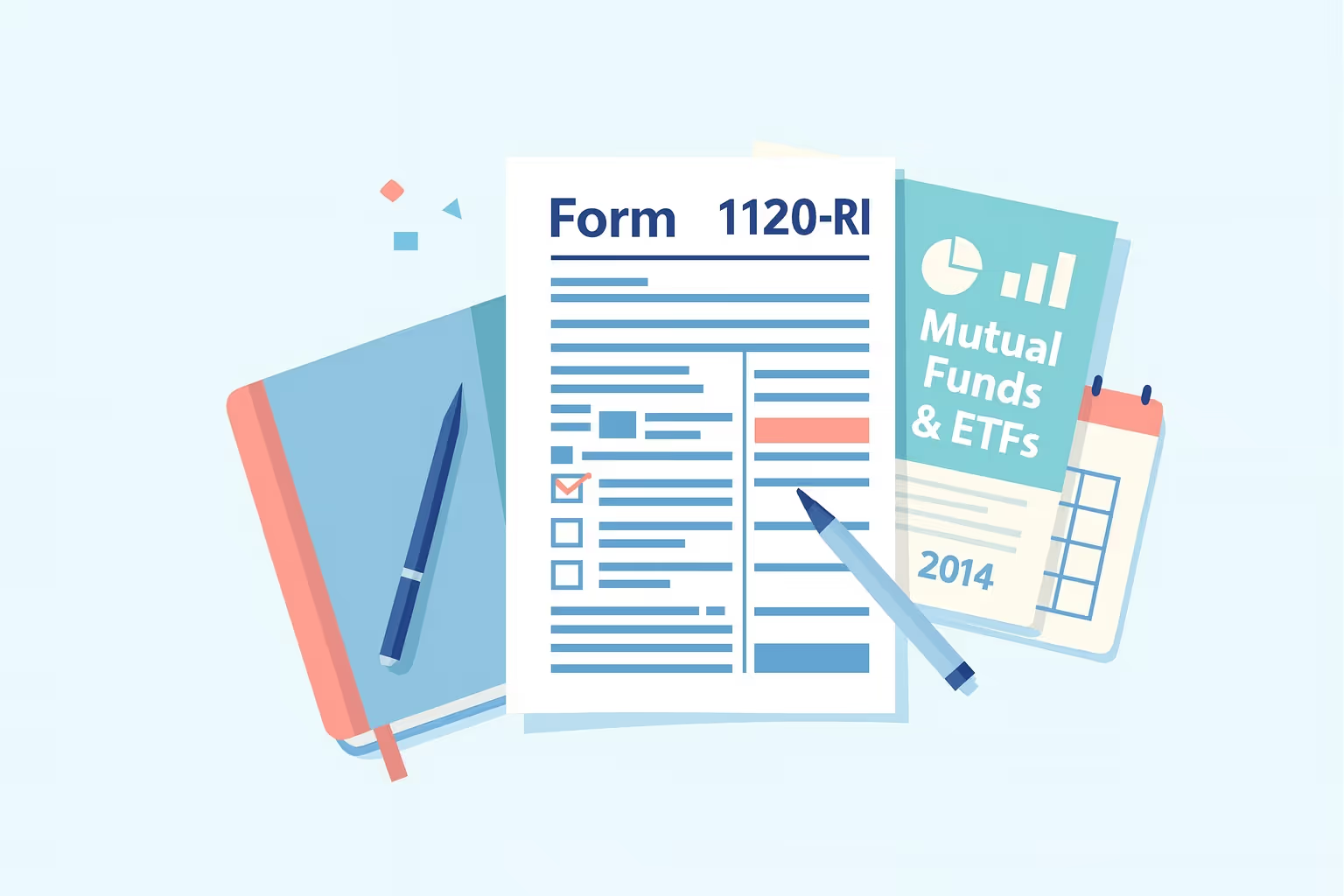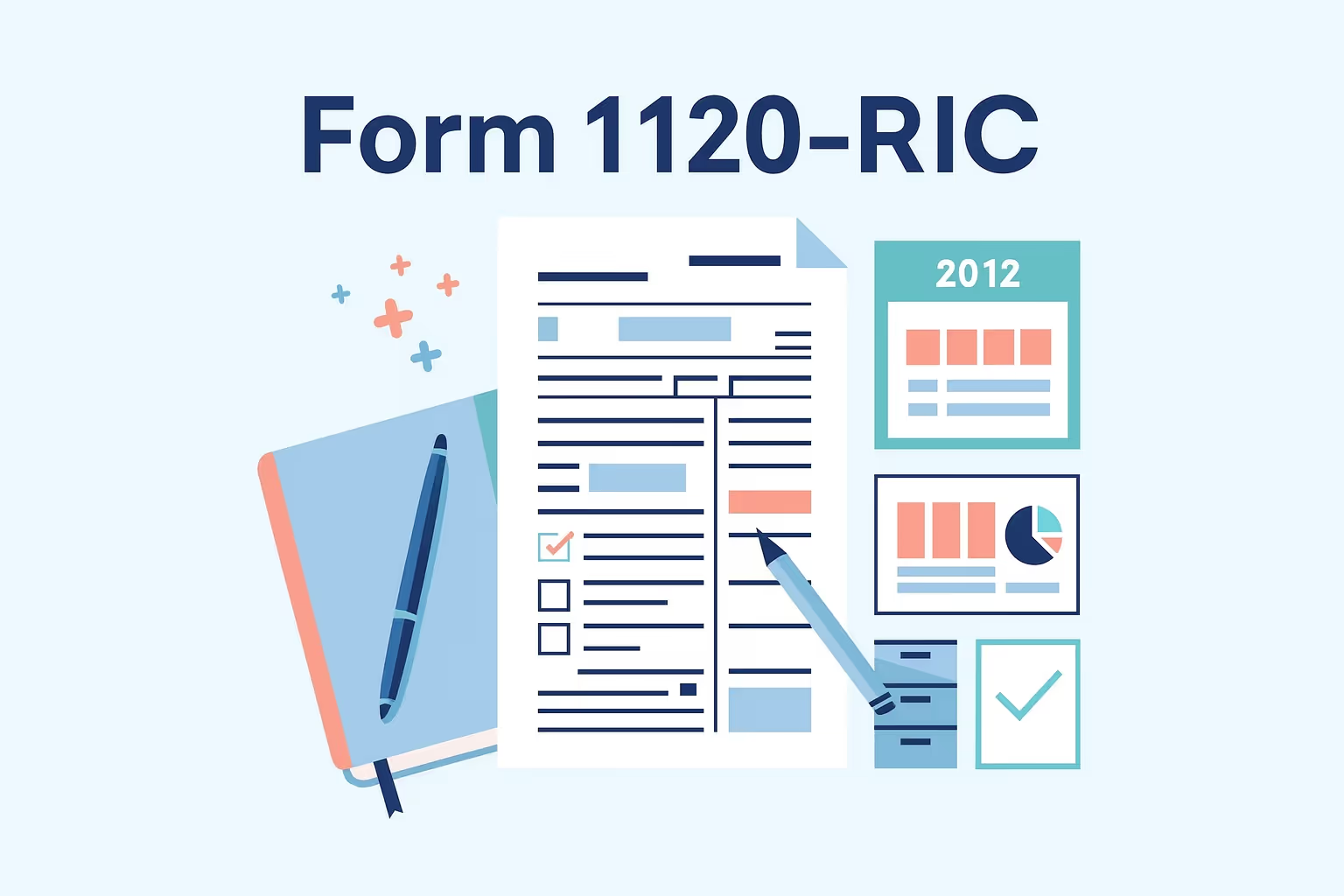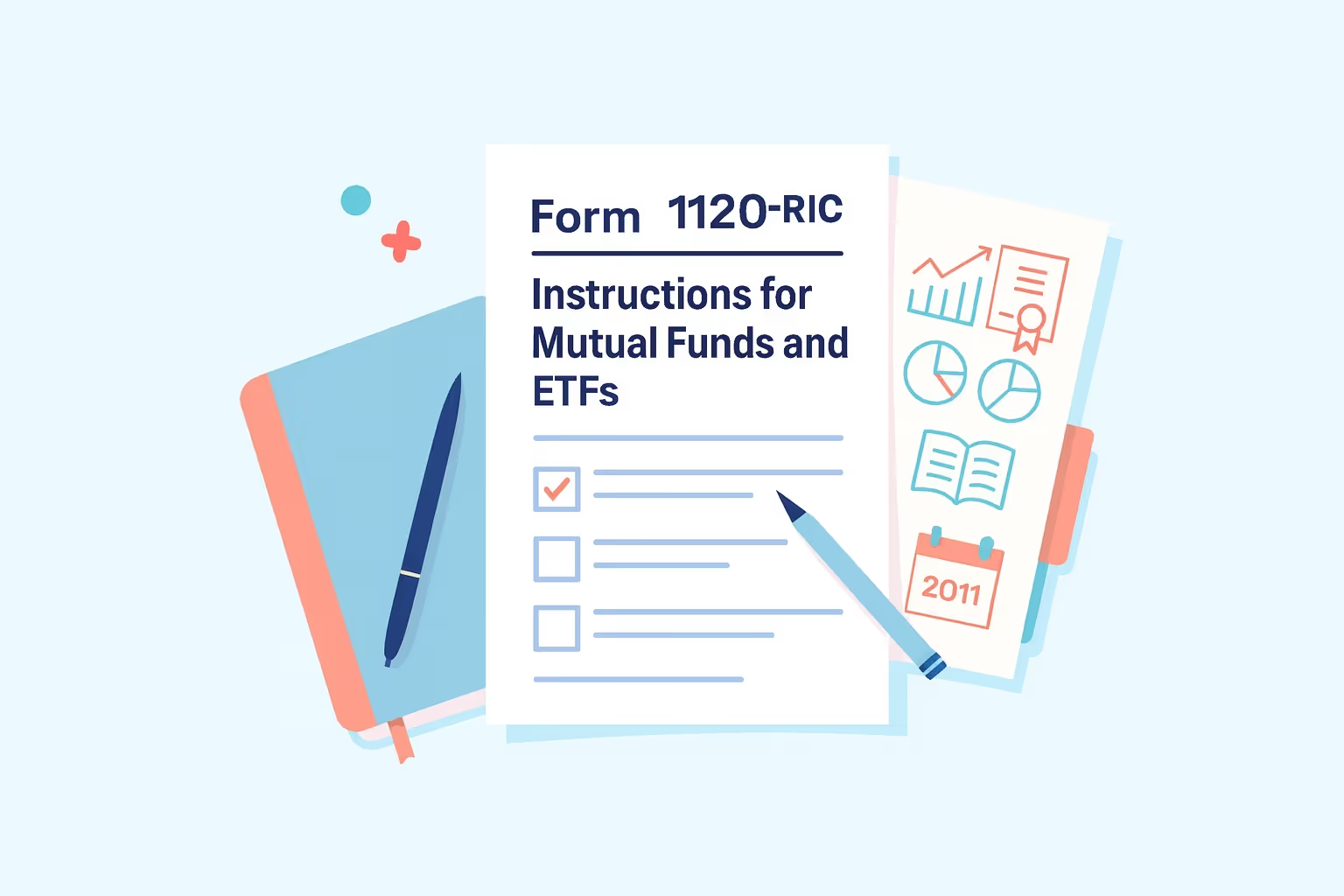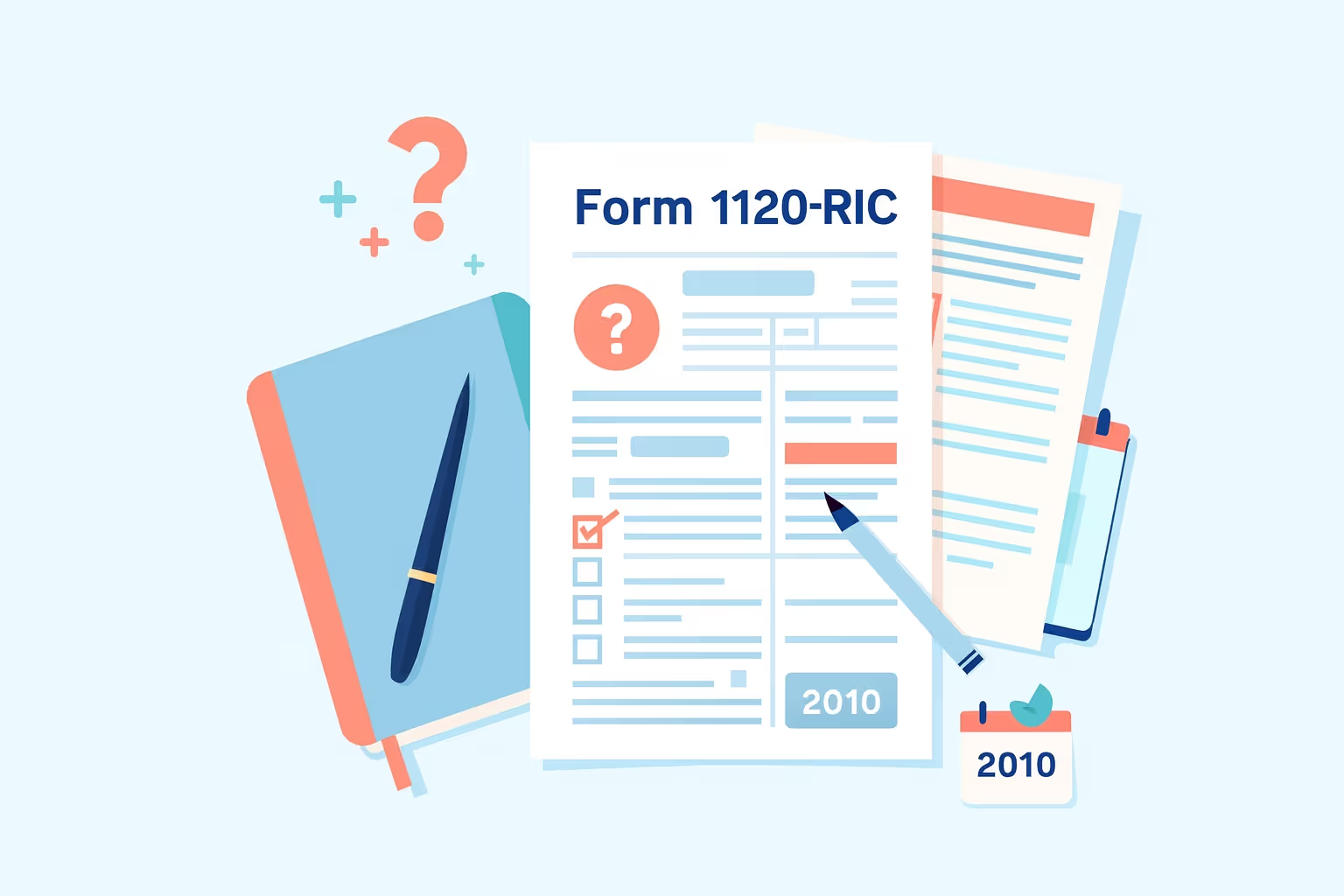Form 1120-RIC 2013 Instructions: Mutual Funds and ETFs
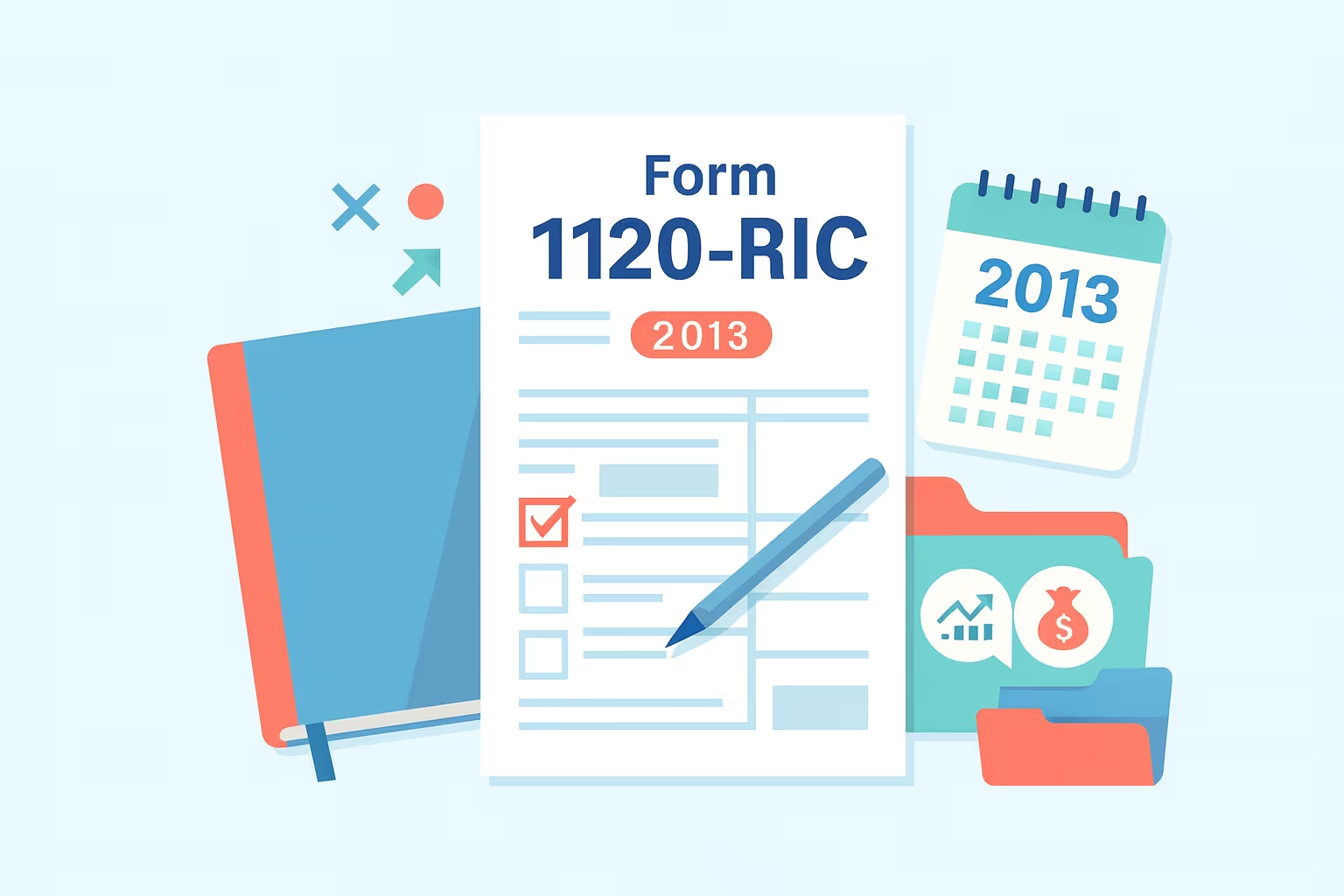
Mutual funds, exchange-traded funds (ETFs), and other entities that elect regulated investment company (RIC) status under Regulations Section 851 must file Form 1120-RIC, U.S. Income Tax Return for Regulated Investment Companies. It reports gross income, taxable income, expenses, and federal tax paid to the Internal Revenue Service. This guide focuses on the 2013 calendar year and assists domestic corporations and foreign corporations in understanding the specific filing requirements applicable to the 2013 tax year.
Regulated investment companies must report investment company taxable income, capital gains, ordinary dividends, and unappropriated retained earnings to ensure transparency and compliance. The return reflects the company’s financial position, including compensation, property values, cash reserves, and accumulated earnings. Maintaining accurate accounting for profits, liabilities, and transactions is crucial, as reporting errors can affect compliance with federal tax rules and influence the treatment of shareholders’ earnings.
The Internal Revenue Service resource, "About Form 1120-RIC," outlines the official requirements and detailed reporting standards for income, deductions, and credits. By following these guidelines, regulated investment companies can document income tax liability and meet reporting standards that reflect compliance with applicable law and accountability to investors.
What Is Form 1120-RIC?
Form 1120-RIC, U.S. Income Tax Return for Regulated Investment Companies, is a federal tax document used by entities qualifying under Section 851 of the Internal Revenue Code. It applies to domestic corporations and foreign corporations that elect RIC status and operate as mutual funds or exchange-traded funds (ETFs). These entities pass income, profits, and capital gains directly to shareholders while meeting strict compliance requirements.
The form reports taxable income, investment company taxable income, gross income, and expenses tied to fund operations. It also discloses capital gains, ordinary dividends, and unappropriated retained earnings that affect income tax liability. Consistent reporting helps maintain RIC classification and prevents double taxation at both the corporate and shareholder levels.
Definition and Purpose
- Regulated Investment Companies (RICs): These entities qualify under Section 851 and distribute earnings to shareholders under federal tax law.
- Tax Reporting: Captures income, expenses, and accumulated earnings to demonstrate transparency and accuracy in taxation.
- Internal Revenue Service Compliance: Confirms adherence to regulations governing profits, liabilities, and financial transactions.
Entities Required to File
- Mutual Funds and ETFs: Organizations registered under the Investment Company Act of 1940 that satisfy income and diversification tests.
- Real Estate Investment Trusts (REITs): Companies combining property investments with RIC-like reporting requirements.
- Controlled Groups: Corporations under common ownership that must consolidate accounting data for compliance.
Reporting Structure
- Part I – Income: Reports gross income, net income, capital gains, and ordinary dividends.
- Part II – Deductions: Lists allowable business expenses, including compensation, accounting, and legal costs.
- Part III – Tax Computation: Calculates total liabilities and federal tax paid after applicable credits.
Form 1120-RIC ensures regulated investment companies meet federal requirements for reporting income, deductions, and earnings. Consistent compliance with these rules helps each corporation maintain RIC status and fulfill its obligations to the Internal Revenue Service.
Key Updates for the 2013 Tax Year
The 2013 tax year introduced several changes to how regulated investment companies (RICs) prepare and file Form 1120-RIC returns. These updates focused on improving electronic payment processes, refining qualification standards, and ensuring accurate reporting of investment company taxable income. Every domestic corporation and foreign corporation filing as a RIC must follow these revised compliance measures.
Electronic Payment Requirements
All regulated investment companies are required to submit federal tax payments through the Electronic Federal Tax Payment System (EFTPS). The Internal Revenue Service mandated electronic deposits to streamline processing and reduce filing errors. RICs had to schedule payments in advance and maintain confirmation records for each deposit to ensure the timely processing of payments.
Foreign Tax Credit Reporting
RICs making foreign tax credit elections under Section 853 were subject to expanded disclosure rules in 2013. Companies had to track foreign-source gross income and verify eligibility before applying for credits. These changes supported accurate cross-border reporting and protected the corporation’s RIC status election.
Excise Tax Obligations
Funds subject to the Section 4982 excise tax on undistributed income must continue filing Form 8613. The form ensures that funds are distributed sufficiently to avoid additional taxation. Filers had to calculate undistributed income carefully and document related transactions that affected shareholder distributions.
Filing Deadlines and Extensions
Corporations filing for the 2013 calendar year had to submit Form 1120-RIC by March 17, 2014. Corporations needing extra time submitted Form 7004 for a six-month extension. Meeting deadlines supported compliance and prevented disruptions in reporting cycles.
The IRS resource, Instructions for Form 1120-RIC (2013), provides comprehensive guidance on reporting requirements, elections, and excise tax considerations. Each update aimed to strengthen accuracy, streamline processes, and reinforce taxpayer accountability. Following these standards ensured proper disclosure of income, expenses, and accumulated earnings within the 2013 filing framework.
Pre-Filing Preparation Checklist
Preparing to file Form 1120-RIC requires structured organization and adherence to Internal Revenue Service guidelines. Regulated investment companies must compile financial records, confirm their eligibility, and verify all information supporting their RIC status election. Following a structured process helps maintain accuracy and compliance in reporting income, expenses, and distributions.
Establish Accounting Framework
- Calendar year filers must record every transaction between January 1 and December 31 to ensure consistent coverage of the reporting period.
- Fiscal year filers must apply the same accounting treatment to all assets, liabilities, and capital accounts throughout their reporting cycle.
Verify Identification and Entity Details
- The Employer Identification Number must match the number registered with the Internal Revenue Service to maintain accurate identification.
- The legal name and address must remain consistent across all forms and supporting documents to avoid mismatched records.
- The ownership structure must include controlled group affiliations and shareholder classifications to confirm compliance with disclosure rules.
Gather Financial Documentation
- Income statements and balance sheets must capture all gross income, accumulated earnings, and unappropriated retained earnings for the filing period.
- Records must include capital gains, ordinary dividends, and cash distributions to shareholders, reflecting the fund’s financial activity.
- Supporting schedules must document property values, purchases, and accrued liabilities connected to each investment transaction.
Track Business and Fund Expenses
- Management and transfer agent fees must be reported as part of regular operational expenses within the accounting ledger.
- Officer compensation must include all payments to executives who oversee fund operations and financial reporting, as well as any other expenses relevant to their roles.
- Professional service fees must document audit, legal, and compliance support to ensure all deductible expenses are correctly recorded.
Review Prior Filings
Corporations must compare prior returns to confirm consistency in profits, capital balances, and retained earnings. Identifying fluctuations across years helps determine whether explanations or adjustments are needed. This review ensures readiness for filing and alignment with Internal Revenue Service regulations.
Completing Form 1120-RIC Step by Step
Filing Form 1120-RIC requires accuracy and attention to each reporting section. Regulated investment companies must follow a structured process to ensure every component reflects their financial activity, liabilities, and compliance obligations. Completing each part systematically helps corporations meet Internal Revenue Service requirements and maintain their RIC status election.
Step 1: Provide Basic Identification Information
Begin with accurate fund identification on the form’s header. Include the legal name, Employer Identification Number, and business address exactly as registered with the Internal Revenue Service. Indicate the correct calendar year or fiscal year reporting period to ensure filings correspond with accounting records.
Step 2: Report Income in Part I
Complete Part I to record all sources of income for the reporting period. Report gross income from dividends, interest, and securities lending transactions. Include capital gains from the sale or exchange of property and ordinary dividends distributed to shareholders.
RICs must identify income from foreign corporations, real estate investment trusts, and controlled group activities to ensure complete reporting. Total income should reconcile with accounting statements to verify the accuracy of the company's taxable income.
Step 3: Enter Deductions in Part II
Part II captures deductible expenses necessary for fund operations: report officer compensation, management fees, and transfer agent costs. Include accounting, audit, legal, and compliance expenses that support corporate governance and tax reporting.
Ensure expenses align with operational records and represent legitimate business costs under federal tax law. Consistency between reported costs and financial ledgers enhances transparency and reliability.
Step 4: Calculate Investment Company Taxable Income
After listing income and deductions, calculate the investment company's taxable income for the period. Subtract total deductions from total revenue to determine net income subject to taxation. Verify that accrued expenses, capital losses, and income adjustments match the corporation’s books.
Include adjustments for unappropriated retained earnings and accumulated earnings to maintain accurate reporting. The computation must reflect both ordinary income and capital gains distributions made during the tax year.
Step 5: Determine Federal Tax Liability
Use Part III to compute total federal tax paid and any credits claimed. Apply eligible tax credit bonds or foreign tax credits to reduce liability where authorized. Funds must ensure that every credit is documented and supported by corresponding transactions or forms.
Review each calculation carefully to ensure compliance with regulations under Section 852 and related sections of the Internal Revenue Code. Proper computation helps avoid filing discrepancies that could affect future audits.
Step 6: Attach Supporting Schedules and Statements
Attach all schedules in the correct sequence. Include Schedules A, J, and M-1 to reconcile earnings, profits, and book-to-tax differences, and include supplemental statements for capital gains, property sales, and distribution records. Supporting attachments strengthen accuracy and demonstrate respect for Internal Revenue Service requirements.
Completing each step with precision ensures that regulated investment companies accurately reflect their taxable income and overall financial condition. Careful attention to each reporting section enables corporations to maintain compliance and preserve their RIC classification under federal law.
Filing and Submission Options
Regulated investment companies must submit Form 1120-RIC accurately and through the appropriate channel to ensure compliance with Internal Revenue Service regulations. Selecting the correct filing method depends on the fund’s size, location, and preference for recordkeeping. Each option offers distinct benefits that enable corporations to maintain accountability and meet deadlines.
Comparison of Filing Methods
Paper Filing
- Key Details: Paper filing remained available for 2013 returns, allowing corporations to maintain physical records.
- Requirements: Mail the completed form with all required schedules, supporting statements, and signatures. Keep certified mailing receipts as proof of timely delivery.
- Best For: Funds that prefer hard copies and direct documentation.
IRS Service Centers
- Key Details: Submissions are routed based on business address and total assets.
- Requirements:
- Send filings from eastern and midwestern states with assets under $10 million to Cincinnati, Ohio.
- Larger funds or entities located in western states must mail to Ogden, Utah.
- Best For: Domestic corporations with specific geographic or asset classifications.
Private Delivery Services
- Key Details: The IRS authorizes select carriers for verified delivery.
- Requirements: Use only approved carriers such as FedEx (Priority Overnight, 2Day), UPS (Next Day Air, Worldwide Express), or DHL (Same Day, Express Worldwide). Keep shipping confirmations in compliance records.
- Best For: Corporations that need verifiable tracking for timely submissions.
Electronic Filing
- Key Details: For the 2013 calendar year, the IRS offered electronic filing as an optional method to improve processing speed and efficiency.
- Requirements: Submit electronically through IRS-approved software, ensuring confirmation receipts and digital attachments are securely stored.
- Best For: Funds seeking faster acknowledgment and streamlined record retention.
Extension Request
- Key Details: Corporations unable to file by the deadline may request an extension.
- Requirements: File Form 7004 before the original due date to receive a six-month automatic extension. Note: The extension applies only to filing, not tax payments.
- Best For: Entities that need additional preparation time while still meeting payment obligations.
Filing through the appropriate method ensures that each regulated investment company fulfills federal reporting obligations. Maintaining documentation, whether electronic or paper-based, reinforces the fund’s compliance record. Accurate submissions within prescribed deadlines protect the corporation’s standing with the Internal Revenue Service and reflect sound governance practices.
Payment and Estimated Tax Rules
Regulated investment companies must follow structured procedures for managing federal tax payments and estimated deposits. Adhering to these requirements ensures timely remittance of liabilities and compliance with Internal Revenue Service regulations. Each payment must align with the company’s reporting period, accounting records, and income tax liability.
- Electronic Federal Tax Payment System (EFTPS): Every regulated investment company is required to use EFTPS to remit federal tax payments and estimated deposits. Payments should be scheduled in advance to avoid delays in processing. Corporations should record confirmation numbers for all transactions to maintain complete documentation.
- Quarterly Estimated Payments: Funds expecting significant income tax liability must make quarterly installments. Due dates typically fall on the 15th day of the fourth, sixth, ninth, and twelfth months of the tax year. Accurate estimates depend on careful calculation of investment company taxable income, gross income, and allowable deductions.
- Federal Tax Application (FTA): The FTA service enables same-day wire payments for urgent deposits. Corporations must coordinate with their financial institutions before initiating these transfers. Keeping proof of each transaction supports compliance and simplifies reconciliation with accounting records.
- Adjustments for Overpayments: Overpaid balances may be applied to future quarters or refunded to the corporation. Each adjustment by the corporation must be recorded to ensure alignment between financial statements and tax filings. Regular reconciliation helps identify timing discrepancies that affect cash flow and liabilities.
- Record-keeping and Documentation: RICs must retain payment receipts, bank confirmations, and transaction records for each deposit made. An organized payment history supports transparency in Internal Revenue Service inquiries or audits. Comprehensive documentation also reinforces financial integrity and demonstrates diligence in compliance.
- Monitoring Income and Expenses: Companies must review net income, capital gains, and expenses throughout the year to refine their estimated tax schedule. Regular monitoring allows timely updates if income projections or distributions change. Proactive oversight prevents underpayments that could impact compliance or result in additional liabilities.
Accurate management of payment schedules reinforces financial accountability and consistency in reporting. Regulated investment companies that meet these deposit and recordkeeping standards strengthen their credibility with regulators. Consistent adherence to payment rules helps maintain RIC status and demonstrates respect for federal taxation requirements.
Required Schedules, Attachments, and Common Mistakes
Regulated investment companies must attach all required schedules and supporting forms when filing Form 1120-RIC. Each attachment provides essential details about taxable income, deductions, earnings, and shareholder distributions. Completing and organizing these documents in the correct order demonstrates compliance and strengthens the accuracy of the corporate return.
Each form must correspond with the sections completed on the primary return. Schedules and attachments help reconcile accounting records, document financial activities, and support the fund’s RIC status election. Missing schedules or inconsistent figures may trigger processing delays or correspondence from the Internal Revenue Service.
Core Schedules to Include
- Schedule A – Deduction for Dividends Paid: Reports dividends distributed to shareholders and supports the deduction that allows funds to avoid double taxation. The figures must match income distribution records.
- Schedule J – Tax Computation: Calculates the total income tax liability, including credits and adjustments. This schedule confirms that the reported federal tax paid aligns with the fund’s investment company taxable income.
- Schedule M-1 – Reconciliation of Income per Books with Income per Return: Aligns accounting profit with taxable income and identifies timing or permanent differences. Accurate reconciliation ensures consistency between book and tax records.
- Schedule M-2 – Analysis of Unappropriated Retained Earnings: Details changes in retained earnings and ensures transparency in the fund’s profit distribution history. This schedule helps verify that accumulated earnings reflect transactions from the reporting year.
- Schedule L – Balance Sheets per Books: Presents the fund’s financial position at the start and end of the tax year, including cash, property, liabilities, and capital accounts. The values must agree with the financial statements prepared for shareholders.
Supporting Forms and Attachments
- Form 2438: Reports undistributed capital gains subject to corporate-level tax under Section 852(b)(3)(A).
- Form 2439: Provides shareholder notification of undistributed long-term capital gains and related credits.
- Form 8613: Documents excise tax on undistributed income for corporations subject to Section 4982. The IRS page "About Form 8613" outlines the requirements for reporting and payment procedures.
- Supporting Statements: Include detailed listings of capital gains, property sales, investment transactions, and foreign tax credits.
Common Mistakes to Avoid
- Failing to include the Employer Identification Number or reporting incorrect identification details.
- Omitting schedules or submitting incomplete statements that fail to reconcile earnings and profits.
- Misstating accumulated earnings, capital gains, or income distributions.
- Recording incorrect figures for management compensation, fund expenses, or property transactions.
- Submitting schedules out of order may delay processing or trigger follow-up inquiries.
Carefully reviewing each attachment ensures consistency between accounting records and tax disclosures. A complete and accurate submission confirms compliance with Internal Revenue Service standards, strengthens confidence among shareholders, and supports the corporation’s ongoing RIC classification.
Frequently Asked Questions
What is Form 1120-RIC U.S., and who must file it?
Form 1120-RIC U.S. is the income tax return for regulated investment companies that qualify under Section 851 of the Internal Revenue Code. Mutual funds, exchange-traded funds (ETFs), and similar entities are required to file this form with the Internal Revenue Service. It applies to domestic corporations that elect RIC status and meet annual income, asset diversification, and distribution requirements while reporting taxable income, capital gains, and distributions to shareholders.
How does a regulated investment company differ from a personal holding company?
A regulated investment company primarily earns income from investments in securities and distributes most of it to shareholders, qualifying for special tax treatment. A personal holding company, in contrast, typically earns passive income, such as dividends or interest, and may be subject to additional taxation. Regulated investment companies meeting Section 851 requirements can avoid double taxation through income distribution, unlike personal holding companies, which must satisfy strict ownership and income composition rules.
What should appear in the subject line of correspondence with the Internal Revenue Service?
When submitting written correspondence or responding to an Internal Revenue Service notice, the subject line should clearly identify the taxpayer’s name, Employer Identification Number, and tax year. Including “Form 1120-RIC” or “Income Tax Return for Regulated Investment Companies” ensures the Internal Revenue Service associates the submission with the correct filing. Consistent labeling supports efficient processing and reduces delays when addressing inquiries or responding to compliance-related requests.
Can an S corporation file Form 1120-RIC?
An S corporation generally cannot file Form 1120-RIC because it operates under pass-through taxation rules under Subchapter S. Regulated investment companies must operate as C corporations to qualify for RIC status. Entities seeking RIC classification must meet specific income and diversification standards and file a corporate tax return that reflects their investment activities. S corporations should evaluate whether converting to C corporation status is appropriate before pursuing RIC eligibility.
What income must be reported on a tax return for regulated investment companies?
A tax return for regulated investment companies must include all gross income derived from dividends, interest, and securities transactions. It also covers capital gains, foreign income, and other investment-related earnings. The form distinguishes between taxable income and tax-exempt income, requiring accurate reporting of each category. Maintaining precise records of income sources ensures compliance with Internal Revenue Service rules and supports the correct calculation of investment company taxable income.
What happens if a regulated investment company fails to meet RIC qualification tests?
If a regulated investment company fails income, asset diversification, or distribution requirements, it loses RIC status for the tax year. The company must then file as a regular C corporation and pay corporate-level income tax. Losing RIC status can increase an investor's overall tax liability and affect the treatment of dividends for shareholders. Restoring eligibility in future years requires strict adherence to qualification standards and timely filing with the Internal Revenue Service.
When is the income tax return for regulated investment companies due?
The income tax return for regulated investment companies is due on the 15th day of the third month after the end of the tax year. For calendar-year filers, the deadline typically falls in March. Entities requiring additional time may request an extension using Form 7004, which only extends the filing date, not the payment deadline. Meeting deadlines ensures timely processing and compliance with Internal Revenue Service regulations.
















